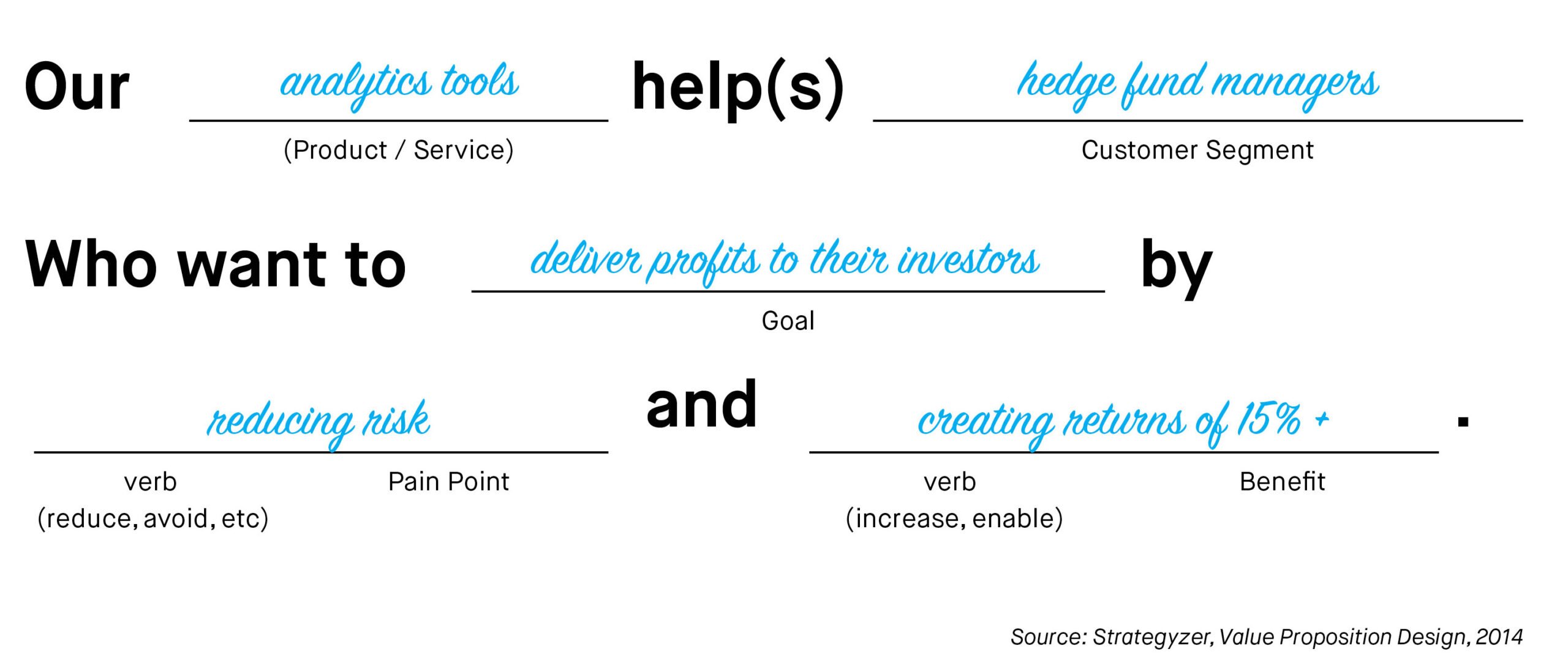Brand Strategy 101: How to create a value proposition that’s actually valuable

Are you looking to create a value proposition for your company and don't know where to start? Read on for an overview and a step-by-step process for success. First, we'll explain what a value proposition is, and why you should care. Next, we'll explore the steps every firm should follow when designing a value proposition along with an easy-to-use template. Finally we'll discuss how you can test, revise, implement, and evolve your value proposition to keep it relevant.
Sound good? Great, let’s get started!
The art and science of creating a value proposition have evolved over the past few decades. There are several paths you can take, but they all revolve around the same core ideas: understand your customers, your market, and how your products or services fit to provide benefits and solve their pain points. It sounds easy, but it requires commitment and a team effort.
So what is a value proposition, and why should you care?
Michael Lanning, author of Delivering Profitable Value (and the person who coined the term ‘value proposition’), describes it as:
- About customers but for your organization
- Not addressed to customers, but must drive these communications
- Articulating the essence of a business, defining exactly what the organization intends to provide in the customer’s life
In other words, it’s at the heart of any B2B firm, especially customer-oriented service businesses. It focuses your daily activities and creates a framework for customer service. It makes your firm more human and delivers a superior experience.
If you’re not convinced this is important, consider that outstanding customer experiences help create loyalty, repeat business, and a lower rate of switching to your competition. It translates directly to your bottom line, which we will all agree is a good thing.
What value propositions are not:
- Feature / benefit lists
- Positioning statements
- Your brand essence
- An elevator pitch
Ok, so we know what a value proposition is and why we should care, how do we go about this business of writing an effective value proposition?

Step 1 – Know your customers and market
Akin to good content marketing, you want to start with your end users. Use observation, online research, interviews and surveys to find answers for the following: What goals are your customers trying to reach in their work and home lives? What emotional needs can your business’s solutions help satisfy? What pains do they encounter – what frustrates them? What makes them smile? How can your product or service improve their lives? Save time? Make them more money?
For example, if you are a SaaS firm, one emotional benefit could be making a customer feel secure in their job because they made the correct software choice for their organization (keeping the Boss happy).
Consider what customer segments are the most relevant and profitable for your company. Who is driving the bottom line today? What about tomorrow, or next year?
Avoid marketing to the broadest possible segment; a narrow niche beats a general, more shallow offering. Being niche is more personal. You exclude some customers, but become more meaningful to others. In this respect, a good value proposition follows the same strategic thinking as a strong positioning statement.
Now, rank your lists by priority (using sticky notes can make the ranking process more manageable).

Step 2: List your products & services (your offerings) and how they benefit your customers
How do your products and services deliver value to the audiences you identified in step one? Start by making a list of all products and services – what they would see if they walked into your store, metaphorically speaking. These could be products like software or services such as consulting.
Next, make a list of how these products and services help your customer segment(s) achieve favorable outcomes, cut risks, or otherwise improve their home or work lives. Like the previous step, rank in order of importance.
Note that “importance” can mean several things. If profit is your primary motivator, then rank the most profitable offerings at the top. Perhaps one service line is not the most useful, but it’s where you are focusing your strategy and efforts because you see growth potential. In that case, it would rank higher.
By now you should intimately understand both your customers and how you deliver value to them. What we’re looking for next is fit, or how your products and services meet their needs and solve their problems. To do this, you must prototype.

Step 3: Prototype your value proposition
Now for the fun part – brainstorming. The goal here is to create many rough, unpolished variants quickly. Review your lists and look for patterns. Where is there overlap? Where can you connect the dots?
Once you have some preliminary ideas, follow a template like the example below, sketch out ideas on paper, or do a group brainstorming. The goal is to generate ideas. It’s important to note that quantity is better than quality – there are no ‘bad’ ideas.
The template
Using the template below or similar, fill in the blanks with answers from the previous exercises (Note you can be flexible with the format; the prepositions are optional. The main idea is to prototype concepts quickly for evaluation by your team).
 Putting this template to use, here are a few examples:
Putting this template to use, here are a few examples:
Travelers using AirBnB:
“Our global platform helps travelers who want to connect with property owners by avoiding scams and enabling safe, secure transactions.”
Business owners at wework:
“Our flexible office solutions help small to mid-sized business owners and entrepreneurs in major cities worldwide who want to lease office space by providing quality inventory with no long-term commitment and including valuable amenities for free.”
Insurance brokers selling Oscar:
“Our technology platform helps insurance brokers who want to sell corporate health plans by reducing paperwork and enabling a seamless, faster onboarding process.”

Step 4 – Refine, Iterate and Implement
Refine & iterate
Now that you have your value proposition concepts, it’s time to prove their worth in the market. You cannot validate them internally, so this means testing them with your customers.
One way to quickly validate is to create a test campaign on Facebook or using Google Adwords. For example, in the hypothetical New York tax firm above, you could test ad creative targeted to the New York metro area around search terms like “personal service” and “fast turnaround.” Use multiple variants and have the ads click through to a “coming soon” landing page. Be sure to measure the clicks! With a small investment, you learn if this proposition resonates in the marketplace.
Other options are consumer research, interviews, and observation, but these typically require more significant investment and an outside firm to manage the process.
If your proposition fails, don’t despair! Return to the drawing board:
- Is there another customer segment that might be a better fit?
- Are you focused on the wrong market or delivering the wrong services?
- Would a change in language resonate better?
Iterate until you have something that feels right to your team and has market validation.
Implement
Ok, you’ve researched, prototyped, tested and validated your shiny new value proposition. Now it’s time to roll it out and conquer! Implementing your value proposition has the potential to transform your brand and forge strong customer relationships. Organizational change isn’t easy, but dramatic results will follow when it’s done right.
Here are some basic guidelines:
- Have a communications plan for your employees. Make sure they know what you stand for and how they can make a difference. Make it specific and clear; don’t let your team misinterpret the message.
- Set priorities and initiatives through the value lens. What will you do now, in the next quarter, and over the next year to deliver? What are the milestones?
- Garner support with critical stakeholders. Your team and senior management will be the key evangelists to promote and deliver on your new value proposition. Talk about it often – repetition is key.

Step 5 – Evolve
To keep up with the acceleration of change in the B2B (or any) market, you must test, evaluate, and re-invent your firm’s value proposition to stay relevant. Don’t wait for a crisis to hit; re-invent while you are enjoying success.
To that end, ask yourself:
- What changes in your business environment are impacting your value proposition?
- What new opportunities are on the horizon?
- Could a change in technology render it obsolete?
- What regulations or competitive changes in your industry will re-arrange the playing field?
In Conclusion
As you can see, creating a value proposition that has lasting value is simple, but not easy. Have a pulse on your customers, markets and solutions, explore all the possibilities, test, iterate and continue to evolve once you’ve gone live.
This article only touches the surface of this process, and you don’t have to go it alone. Seek expert help to guide you, and if you want to read more, there are lots of great books and articles on the subject.
Here’s two that I found valuable:
Value Proposition Design, by Strategyzer
Creating and Delivering on your Value Proposition, by Cindy Barnes, Helen Blake and David Pinder
If this article helped you, please help us by sharing it or recommending to a friend. Thank you!


